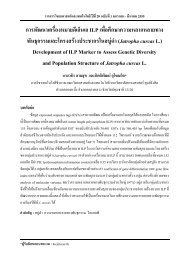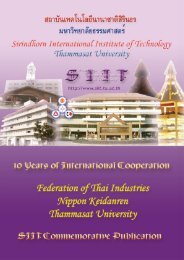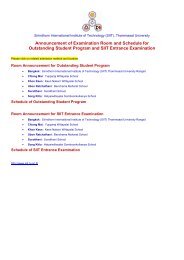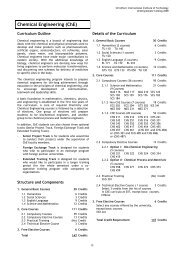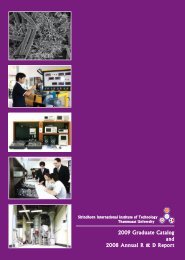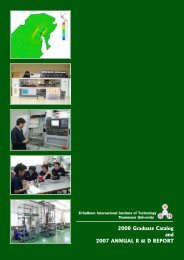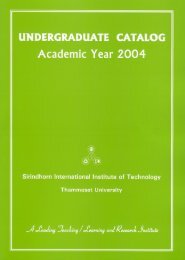2007 Graduate Catalog and 2006 Annual R & D Report - Sirindhorn ...
2007 Graduate Catalog and 2006 Annual R & D Report - Sirindhorn ...
2007 Graduate Catalog and 2006 Annual R & D Report - Sirindhorn ...
Create successful ePaper yourself
Turn your PDF publications into a flip-book with our unique Google optimized e-Paper software.
<strong>2007</strong> <strong>Graduate</strong> <strong>Catalog</strong> <strong>and</strong> <strong>2006</strong> <strong>Annual</strong> R & D <strong>Report</strong><br />
<strong>Sirindhorn</strong> International Institute of Technology (SIIT)<br />
Research Interests:<br />
Semantic Web<br />
The basic idea of the Semantic Web is to describe the<br />
meaning of Web data in a way suitable for automatic<br />
reasoning. Expectedly, the Semantic Web<br />
technology will bring about large-scale heterogeneous<br />
Web knowledge bases with a qualitatively new level<br />
of service. The concept of ontology (domain theory)<br />
will play a key role as a formal, explicit specification of<br />
shared conceptualizations that describe the<br />
semantics of data on the Web. Formal ontology<br />
languages as well as meta-level representation of<br />
Web resources are investigated. The possibility of<br />
developing automated reasoning systems for<br />
Semantic Web is explored from both theoretical <strong>and</strong><br />
practical viewpoints, e.g., a hybrid approach with a<br />
strict separation between ontology predicates <strong>and</strong><br />
rule predicates <strong>and</strong> a homogeneous approach<br />
embedding rules <strong>and</strong> ontologies in a logical language.<br />
Realization of the Semantic Web vision dem<strong>and</strong>s<br />
further research works on several other knowledgerepresentation-related<br />
issues.<br />
Reasoning with UML Diagrams<br />
The Unified Modeling Language (UML) is a graphical<br />
language, adopted as a st<strong>and</strong>ard by the Object<br />
Management Group (OMG) for visualizing, specifying,<br />
constructing, <strong>and</strong> documenting the artifacts of a<br />
software-intensive system. As reported by recent<br />
works on the formal semantics of UML, there exist<br />
inherent interrelationships between components of a<br />
UML model. Such interrelationships constitute part of<br />
general knowledge about the domain of UML, which<br />
may be used for, e.g., deriving implicit properties <strong>and</strong><br />
verifying the consistency of the model. A framework<br />
for knowledge representation <strong>and</strong> reasoning in the<br />
domain of UML is proposed, in which a UML model is<br />
represented as textual XML data, <strong>and</strong> the general<br />
knowledge about the UML domain as an XML<br />
declarative description. Development of an inference<br />
engine for automatic refinement of the encoded UML<br />
diagrams <strong>and</strong> derivation of implicit model properties is<br />
underway.<br />
Equivalent-Transformation Computation Model<br />
In declarative paradigms, a declarative description<br />
plays the role of a precise specification, <strong>and</strong>, at the<br />
same time, operates as a program. A number of<br />
works on amalgamation <strong>and</strong> generalization of<br />
declarative languages have been proposed. Most of<br />
them have been driven mainly by computationoriented<br />
requirements, e.g., enhancement of<br />
operational semantics <strong>and</strong> integration of computation<br />
models; other important related concepts such as<br />
program synthesis <strong>and</strong> program transformation are<br />
investigated only afterwards <strong>and</strong> not inherent in their<br />
designs. By contrast, the equivalent transformation<br />
(ET) paradigm takes a program-synthesis-oriented<br />
approach, i.e., effective generation of efficient <strong>and</strong><br />
correct programs from specifications is its underlying<br />
design motivation. Theoretical investigation of the ET<br />
computation model is in progress.<br />
A Theoretical Framework for Comparing<br />
Computation Models<br />
Systematic generation of programs relies on some<br />
specific practically-determined correctness relation,<br />
which associates with each specification a number of<br />
cost-effectively-derivable correct programs with<br />
respect to it. Between two such correctness<br />
relations, if one is more expressive than the other, the<br />
former is preferable, i.e., it determines a larger space<br />
of derivable correct programs. Program generation in<br />
different computation paradigms, e.g., logic<br />
programming (LP), constraint logic programming<br />
(CLP), functional programming (FP), functional logic<br />
programming (FLP), <strong>and</strong> equivalent transformation<br />
(ET), employs different correctness relations, <strong>and</strong> the<br />
expressiveness thereof cannot be compared directly<br />
due to the discrepancy in the forms of specifications,<br />
programs <strong>and</strong> computations. The need arises for a<br />
means of comparing the expressiveness of<br />
correctness relations across computation frameworks.<br />
Dr. Komwut Wipusitwarakun<br />
Assistant Professor<br />
B.Eng. (Honors) in Electrical Engineering, Chulalongkorn University, Thail<strong>and</strong><br />
M.Eng. in Communication Engineering, Osaka University, Osaka, Japan<br />
Ph.D. in Communication Engineering, Osaka University, Osaka, Japan<br />
Areas of Specialization: Broadb<strong>and</strong> communication networks, Network reliability analysis, Self-healing network<br />
design, ATM <strong>and</strong> TCP/IP technologies, Congestion control technologies.<br />
Research Interests:<br />
Highly Reliable Wide Area Network Design<br />
In the coming “Information Age”, business <strong>and</strong> daily<br />
life will be highly reliant on telecommunication<br />
services. All organizations, companies <strong>and</strong> ordinary<br />
homes will be connected together by the Wide Area<br />
Communication Networks (WAN) so that various<br />
kinds of services, provided at anywhere, can be<br />
accessible from everywhere at anytime. Network<br />
reliability will become a vital concern since the failure<br />
of network functionality will result in a significant<br />
impact on a wide-range of users both in tangible <strong>and</strong><br />
intangible forms. Thus, technologies for designing<br />
<strong>and</strong> assuring the high reliability of WAN are needed.<br />
These include, for example, theory <strong>and</strong> tools to<br />
analyze the reliability-level of networks, automatic rerouting<br />
algorithms (self-healing algorithm) design,<br />
reliability-level based traffic prioritizing scheme,<br />
24




